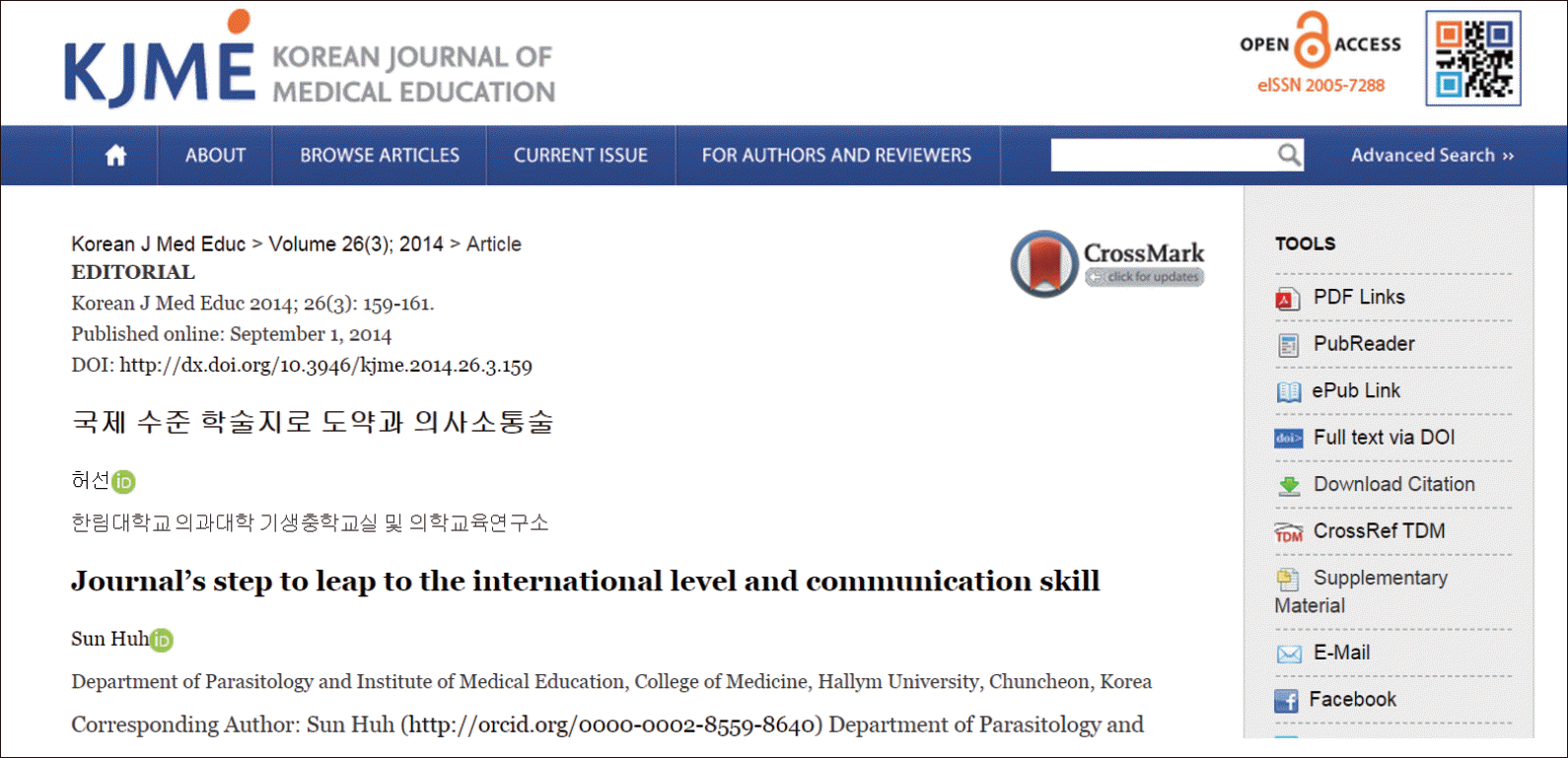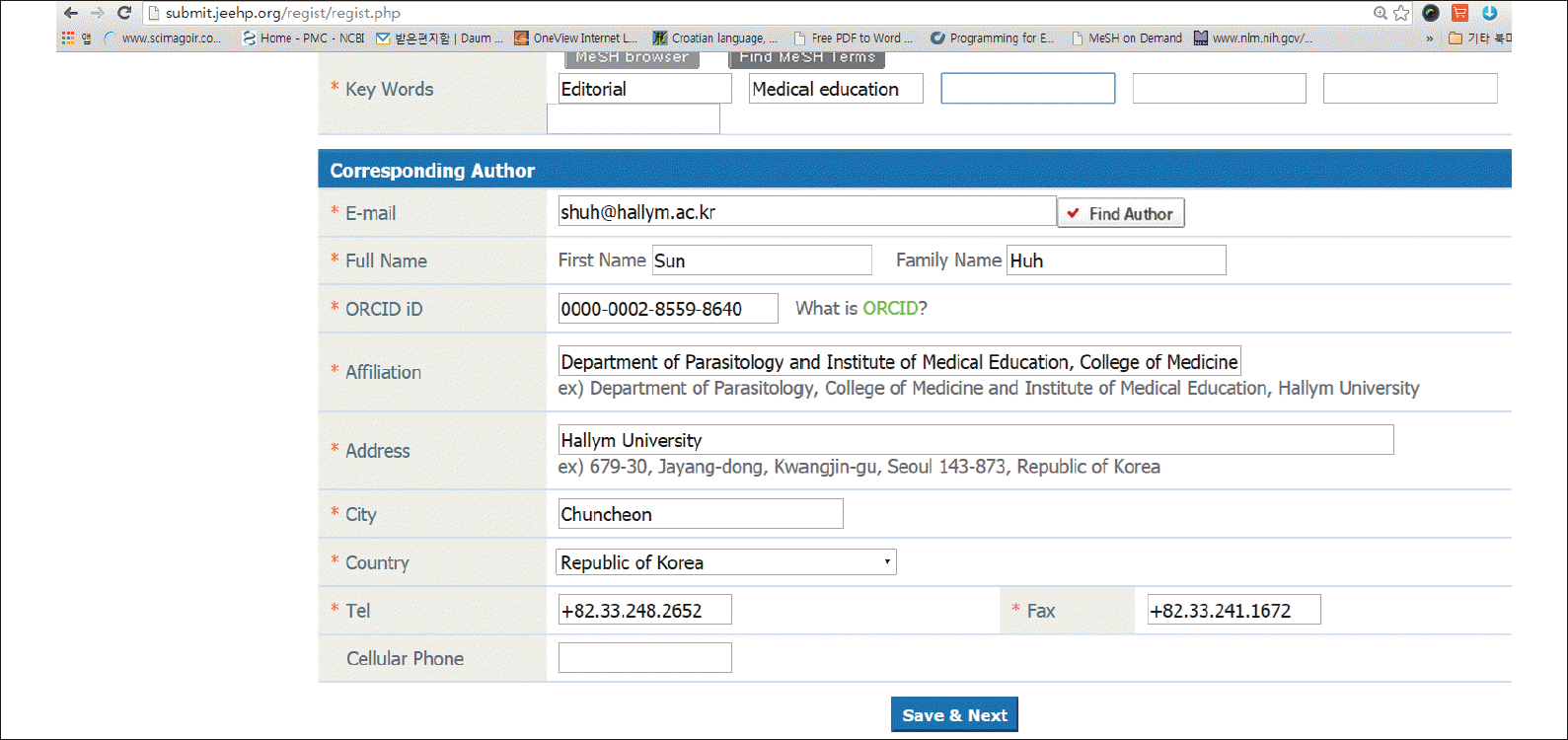Articles
- Page Path
- HOME > Sci Ed > Volume 2(1); 2015 > Article
-
Training Material
Applying Open Researchers and Contributors ID in scholarly journals -
Jeonghee Im

-
Science Editing 2015;2(1):28-31.
DOI: https://doi.org/10.6087/kcse.33
Published online: February 28, 2015
M2 Community, Seoul, Korea
- Correspondence to Jeonghee Im heeya033i@m2community.co.kr
• Received: December 30, 2014 • Accepted: January 23, 2015
Copyright © Korean Council of Science Editors
This is an open access article distributed under the terms of the Creative Commons Attribution Non-Commercial License (http://creativecommons.org/licenses/by-nc/3.0/), which permits unrestricted use, distribution, and reproduction in any medium, provided the original work is properly cited.
- Abstract
- Introduction
- Definition of Open Researchers and Contributors ID
- Why Add Open Researchers and Contributors ID
- How to Add Researcher Information to Open Researchers and Contributors ID
- Coding of the Open Researchers and Contributors ID Tag and Integration into the Journal Article Tag Suite Extensible Markup Language File
- Integration of Open Researchers and Contributors ID into the Manuscript Management System
- Conclusion
- Notes
- References
Abstract
- Open Researchers and Contributors ID (ORCID) launched its registry services in October 2012. Consequently, adding personal information to the ORCID registry became routine work for researchers. To add ORCID to an online article, the tag < contrib-id contrib-id-type = “orcid” > needs to be included in the Journal Article Tag Suite extensible markup language file, if such a file has been produced by the publisher. Subsequently, all co-authors’ ORCID can be easily and conveniently collected and then integrated into the manuscript management system. In the current age of information and the Internet, journals need to keep pace with the surge of new standards and technologies. Editors should be able to accept and apply these new systems rapidly.
- The Open Researchers and Contributors ID (ORCID) registry was launched on October 16, 2012 (http://orcid.org). This article presents a description of ORCID and a step-by-step guide for adding ORCID data to Journal Article Tag Suite (JATS) extensible markup language (XML) files.
Introduction
- ORCID represents an open, non-profit, community-driven effort to create and maintain a registry of unique identification for researchers. It is operated by ORCID, Inc., which has made the ORCID registry available free of charge to individuals. ORCID records hold non-sensitive information, such as the name, email, affiliation, and research activities of authors. ORCID offers two core functions: first, a registry provides a unique identifier and manages a record of activities; second, an application programming interface supports system-to-system communication and authentication [1]. Through ORCID, researchers can maintain and modify their research using their unique identifier. They can choose the information from their research results that they would like to share, including setting the range of their publicly available excerpt. With the permission of the researchers concerned, references can be downloaded in a standard form. Further, all development programs are disseminated by an open-source software license.
- The structure of an ORCID is as follows: http URL+16-digit number. An example is http://orcid.org/xxxx-xxxx-xxxx-xxxx or http://orcid.org/0000-0002-8559-8640. The numbers from 0000-0001-5000-0007 to 0000-0003-50000-0001 are issued and assigned randomly.
Definition of Open Researchers and Contributors ID
- Many researchers inevitably share the same name, and as such, exact identification is necessary. Other systems have been proposed and used, including Thomson Reuters’s Researcher ID and Elsevier’s Scopus. As these two systems are operated by commercial companies, the founders of ORCID sought to provide a general, public registry system. An ORCID contains not only the published or presented works of authors but also information on authors’ bibliography, education, and funding history. For researchers registered in ORCID, their publications can be traced by institutes easily without needing to tap into the database of other institutions. As the ORCID system is adopted by many scholarly journals, authors can enjoy the advantages of having their complete records in ORCID.
Why Add Open Researchers and Contributors ID
- ORCID registration can be done at https://orcid.org/register. To add information to ORCID, researchers should sign in to the system through https://orcid.org/signin. Adding articles to ORCID is easy as long as they are registered in CrossRef, Scopus, Web of Science, Europe PubMed Central, and other platforms.
How to Add Researcher Information to Open Researchers and Contributors ID
- The ORCID appears on the print copy either at the top or bottom of an article. It may be indicated, for example, as corresponding author: Sun Huh (http://orcid.org/0000-0002- 8559-8640), or ORCID, Sun Huh: http://orcid.org/0000-0002- 8559-8640.
- Fig. 1. shows an ORCID appearing on the online version of a paper. To integrate an ORCID into the online version of the paper, certain tags need to be added to the JATS XML as shown in the following example for Sun Huh at the Department of Parasitology and Institute of Medical Education, College of Medicine, Hallym University, Chuncheon, Korea:
- <contrib-group>
- <contribute contribute-type= “author”>
- <contrib-id contrib-id-type = “orcid”>http://orcid.org/0000-0002-8559-8640</contrib-id>
- <name> < surname> Huh< /surname>
- <given-names> Sun< /given-names>
- </name>
- </contrib>
- <aff > Department of Parasitology and Institute of Medical Education, College of Medicine, Hallym University, Chuncheon < country > Korea < /country>
- </aff>
- </contrib-group>
- If XML was not used in web publication, hypertext markup language coding can be added as follows:
- Sun Huh<a href=“http://orcid.org/0000-0002-8559-8640” alt=“http://orcid.org/0000-0002-8559-8640” title=“http://orcid.org/0000-0002-8559-8640” target=“_blank”>
- <img src=“/image/icon/orcid.gif” valign=“middle”> </a>
- In this coding, orcid.gif is an icon of ORCID. Clicking this icon leads to the author at ORCID site.
Coding of the Open Researchers and Contributors ID Tag and Integration into the Journal Article Tag Suite Extensible Markup Language File
- The best way to add an ORCID tag is to integrate the ORCID info into the manuscript management system or e-submission system involved, as shown in Fig. 2. At present, many manuscript management systems provide an ORCID field on author information in their page.
Integration of Open Researchers and Contributors ID into the Manuscript Management System
- Journal publication continues to adopt new international standards and information systems, bolstered by advances in information technologies, especially the Internet. At present, the online version of journal articles reaches a wider audience and provides more convenient than the print version. To survive in the information and Internet age, journals should be equipped with all the new systems for organizing data, including ORCID, which is simple to be introduced in online journal publishing, requires the inclusion of one ORCID tag only, namely <contrib-id contrib-id-type = “orcid” > </contribid> in the JATS XML file. Collectively, authors are encouraged to add their ORCID information by integrating an ORCID field in the manuscript management system.
Conclusion
-
Acknowledgements
- This work is supported by a research grant of the National Research Foundation of Korea (policy research-2013-003-academic infrastructure promotion) and Korean Federation of Science and Technology Societies (KOFST-2013), the Government of the Republic of Korea.
Fig. 1.Screen shot of an article that has an ORCID (Open Researchers and Contributors ID) tag (Available from: http://dx.doi.org/10.3946/kjme.2008.20.4.375).


Fig. 2. Integration of author's ORCID (Open Researchers and Contributors ID) information into an e-submission system (Available from: http://submit.jeehp.org/).


- 1. ORCID. What is ORCID? [Internet]. Bethesda, MD: ORCID [cited 2014 May 10]; Available from: http://orcid.org/node/47.
References
Figure & Data
References
Citations
Citations to this article as recorded by 

- Position of Ultrasonography in the scholarly journal network based on bibliometrics and developmental strategies for it to become a top-tier journal
Sun Huh
Ultrasonography.2020; 39(3): 238. CrossRef - Journal of Educational Evaluation for Health Professions will be accepted for inclusion in Scopus
Sun Huh
Journal of Educational Evaluation for Health Professions.2019; 16: 2. CrossRef -
Endocrinology and Metabolism Has Been Indexed in MEDLINE: A Major Achievement
Won-Young Lee
Endocrinology and Metabolism.2019; 34(2): 138. CrossRef - Journal metrics of Clinical and Molecular Hepatology based on the Web of Science Core Collection
Sun Huh
Clinical and Molecular Hepatology.2018; 24(2): 137. CrossRef - How much progress has Blood Research made since the change of the journal title in 2013
Sun Huh
Blood Research.2018; 53(2): 95. CrossRef - Recent advances of medical journals in Korea and and further development strategies: Is it possible for them to publish Nobel Prize-winning research?
Sun Huh
Journal of the Korean Medical Association.2018; 61(9): 524. CrossRef -
Endocrinology and Metabolism Is Indexed in the Emerging Sources Citation Index
Won-Young Lee
Endocrinology and Metabolism.2017; 32(3): 350. CrossRef - How to PrepareEndocrinology and Metabolismfor Reapplication to MEDLINE
Sun Huh
Endocrinology and Metabolism.2017; 32(1): 58. CrossRef - Promotion ofNeurointerventionto International Journal Based on Journal Metrics
Sun Huh
Neurointervention.2016; 11(1): 5. CrossRef - Journal of Gastric Cancer's Promotion to International Journal from the Perspective of Biliometric Analysis
Sun Huh
Journal of Gastric Cancer.2016; 16(1): 8. CrossRef - Status of digital standards in Korean medical journals in 2016
Geum Hee Jeong, Sun Huh
Science Editing.2016; 3(2): 100. CrossRef -
Clinics in Orthopedic Surgery's Evolution into an International Journal Based on Journal Metrics
Sun Huh
Clinics in Orthopedic Surgery.2016; 8(2): 127. CrossRef - How much progress has been made in journal metrics two years after the citation analysis of theKorean Journal of Urology?
Sun Huh
Korean Journal of Urology.2015; 56(4): 276. CrossRef - Evidence of the Internationalization ofClinical EndoscopyBased on Journal Metrics
Sun Huh
Clinical Endoscopy.2015; 48(4): 317. CrossRef - The Elevation ofAnnals of Rehabilitation Medicineto the Status of an International Journal After Adopting an English-Only Policy
Sun Huh
Annals of Rehabilitation Medicine.2015; 39(5): 661. CrossRef - How much is Journal of Educational Evaluation for Health Professions promoted based on journal metrics?
Sun Huh
Journal of Educational Evaluation for Health Professions.2015; 12: 57. CrossRef

 KCSE
KCSE
 PubReader
PubReader ePub Link
ePub Link Cite
Cite



